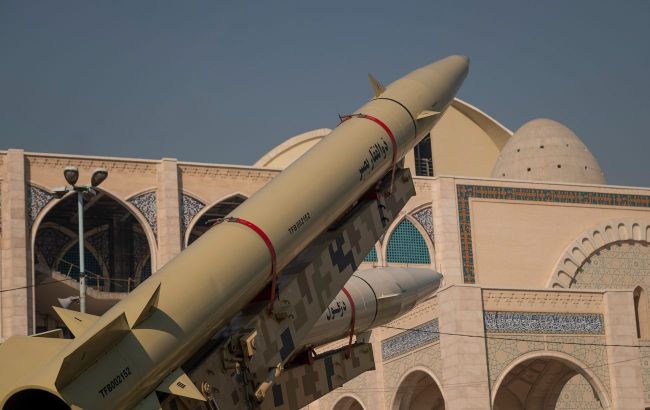What's wrong with the range of Iranian missiles and what threat can they pose alongside Shaheds
 What's wrong with the range of Iranian missiles and what threat can they pose alongside Shaheds (Getty Images)
What's wrong with the range of Iranian missiles and what threat can they pose alongside Shaheds (Getty Images)
The range of Iranian missiles that Russia wants to acquire from Iran is 500-700 kilometers. However, their precision is not definitively known, and it is possible that Russians may only need them to make noisy data for radar systems amid aerial terror with Shaheds and other weaponry.
Aviation expert Konstiantyn Kryvolap commented to RBC-Ukraine on the actual long-range capabilities of Iranian missiles and how Russia could use them.
What about the range of Iranian missiles?
They have a decent range, having various modifications. They started from around 200 kilometers, and now there are versions that can reach 500-700 kilometers. Iranians don't export them extensively, so they do not fall under the restrictions for medium-range missiles. In other words, they can manufacture the missiles for their own use without many export limitations; the export limitations used to be focused on limiting the range to 300 kilometers.
The crucial aspect of a missile or drone is its ability to fulfill its function. A missile is quite an expensive weapon, and if it merely covers an area and doesn't hit its intended target, what's the point? A war of attrition requires careful financial planning. Shaheds are flying, and their current cost is around 30-40 thousand dollars, but the price has increased because they are now equipping them with satellite phones.
The precision of Iranian missiles is a mystery, and no one knows it for certain. The question is whether they need this precision. Considering everything, their idea is to disrupt the Ukrainian heating season. It's their concept, strategy, and task, and they will execute it. They will try to do it using different resources.
First and foremost, they have Shaheds. There was also information that they deployed 46 Iskander missiles along the northern borders, including cruise and ballistic missiles. There are reports that they are currently modernizing the S-400 to make it more precise, like ballistic missiles.
"Russia has to beg from Iran"
The Russians have a significant number of S-400 systems that they are trying to modernize. In this situation, Russia's connection with Iran is unfortunate as they have to ask, beg, humble themselves, and exchange them for Su-35 aircraft. They don't want to do this, as far as I understand. They still have ground-based missile systems. For ground-based use, they had the idea of using the Kh-35 as part of the Bal coastal missile complex. These Kh-35 missiles are interesting, and the Kh-59 is, one could say, a lighter version of Storm Shadow/Scalp and Taurus. They even look similar to Taurus, but their guidance system is not as advanced, and they lack the same control systems.
The Russians want to reach a target of around 500 Shaheds per month. They will have three sources: direct supplies from Iran, domestic production, and a combination of both, with significant assembly processes. These assemblies will include both Russian and Iranian components, but they will be large-scale to allow for quick assembly and launch.
They will obviously vary in quality and precision, with different guidance systems. They want to reach a quantity of 500 per month. Last month, they produced 503 drones. I believe they will try to organize logistics and launch them from four locations – Cape Chauda (Crimea), Primorsko-Akhtarsk, Kursk Airfield (Russia), and somewhere else. They will attempt to launch them in large numbers at different intervals to confuse our air defense systems.
How Russia could use Iranian missiles if acquired
It's not excluded that they may use these Iranian missiles, but not as a means of striking military targets or infrastructure. Perhaps they will use them just to make noisy data for our radar operators and terror acts in Ukrainian cities, no matter where they land.
The Russians want to increase the number of objects flying towards us, and we want to find a way to categorize and destroy all targets. An 80% success rate is quite high. But if they send 50 missiles every night, plus Shaheds, then 20% will hit somewhere. That's their calculation.
While earlier we shot down Shaheds with fighter jets, chased them with helicopters, and fired missiles at them, now we can shoot them down with small arms fire.
We are trying to automate all close-range defense systems. The ideal situation is when your means of destroying the aircraft are cheaper than the aircraft itself, then you win the war of attrition. Currently, the battle is to shoot down Shaheds with small arms fire, making it a separate task that can be handled by mobile groups.
Information about Iran and its defense industry involves identifying the object based on indirect signs. In other words, what they announce at exhibitions and forums can't always be trusted. I analyze the geometry of these missiles and compare it with the geometry of other missiles, and I understand that these missiles can fly 500-700 kilometers. They claim they can fly a thousand, but I don't believe that.
We should assume that these will be precise missiles in significant quantities. The Russians will seek to solve this problem by straining their logistics and all logistical and military chains to the maximum. This will need to be programmed, and the mobile missile systems will have to be deployed so that we cannot strike them.

